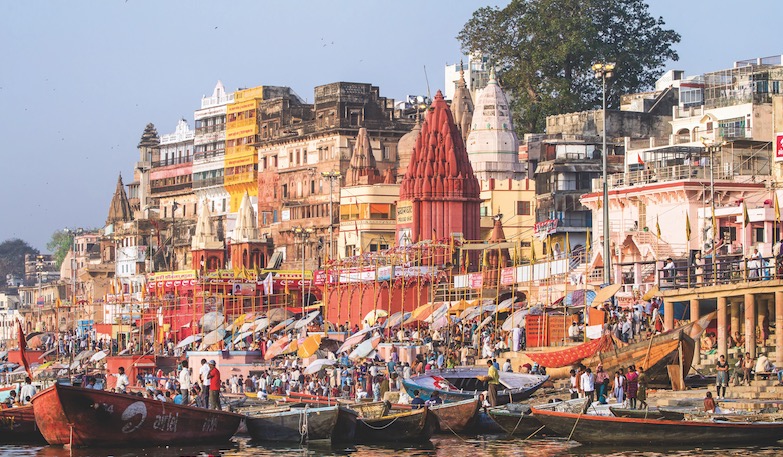A panorama of the ghats
THE GHATS
______________________
Pilgrims flock to the steps leading into the Ganga
______________________
ARTICLES BY RAJIV MALIK
“IF YOU WANT A TRUE AND REAL EXPERIENCE of Kashi, spend your time on the ghats.” The saints and common residents of Varanasi alike offer this advice. They explain that Lord Siva Himself is believed to be walking and meditating along the river. No doubt, it is the ghats that draw pilgrims to this most holy of Hindu cities, to worship, to meditate, to bathe in the sacred river, to perform last rites and, for some, to depart this earthly life in hopes of liberation from rebirth.
At all times of day, photographer Arun Kumar Mishra and I took every opportunity to be on the ghats—the wide stone steps that allow easy access to the river. At 4:30am at Assi Ghat, hundreds of devotees were there ahead of us, making Sivalingams for the special pujas that are performed in the month of Kartik, singing bhajans and conferring offerings to the river.
Unexpectedly, at the break of day everything came to a standstill. The rising sun cast flittering shades and colors on the river’s flowing waters, and the sounds of the day played a symphony—the river, the temple bells, the ancient mantras eternally chanted.
Many priests set up temporary workplaces on the ghats, small platforms under large umbrellas where they help devotees perform their daily pujas. At Assi Ghat, for example, six to eight priests are regularly present. Many priest families have worked on these ghats for generations, serving the same families generation after generation. Serving anyone who arrives for worship, most require no fixed fee; anything offered by the devotees is welcome.
Young priests attend school later in the day, then return in the evening. Sanjeev Kumar Dubey, at Goswami Tulsi Ghat, just 16, comes early in the morning, attends to several dozen clients, then goes to school at 10am.
Priest Siva Kumar’s family is originally from Thanjavur in South India. His great-grandfather settled here in 1902. Siva Kumar serves as part of a pilgrimage program that links Rameshvaram, Varanasi, Gaya and Prayag. He explained, “Previously, for the liberation of the ancestors, one had to go to 54 places of pilgrimage and perform the pind daan, etc. This new system is a shortcut for serving the same purpose. Our pilgrimage is called Setu Yatra. We have priests in Rameshvaram, Gaya and Prayag who perform and conduct all the requisite rituals and pujas.” The yatra, he said, is highly popular with South Indians, especially Tamils.
For some pujas, the devotee stands in the midst of the holy Ganga while the Vedic mantras are chanted by the priest. Most devotees come to make the pind daan—offering food and prayers to their ancestors. Adi Sheshan, one of Siva Kumar’s clients, is a 75-year-old from Chennai, here with his sister-in-law. Over the last six days, with Kumar’s help, they have done pind daan for 64 people—ancestors, parents, relatives and friends, all at a cost of about US$400.
Pilgrims and tourists alike avail themselves of a boat ride along the ghats. Gliding along the calm river, they imbibe the majesty of the ghats, and the grand and famous old temples and other buildings along the shore. It was for me a most enjoyable and uplifting experience.
Varanasi is a huge center for learning, home to thousands of institutions, including Banaras Hindu University, one of the largest in Asia. Many students congregate on the ghats in what rare free time they have. They use the ghats as a picnic spot to chat with peers, or take a boat ride and enjoy the picturesque and serene environment.
Saints and sadhus are abundant here; but, unlike Rishikesh, this is not known as a place to interact with them. As Dandiswami Jitendrananda Saraswati told us, “The saints here in Kashi are pursuing their own sadhana as they march towards brahma tattva (liberation). They hardly have any interest in meeting anyone.” Interaction is possible, though, and many sannyasin akharas, or orders, have facilities here, or one may encounter a sadhu along the ghats.
Come evening, a huge Ganga Arati ceremony is conducted by the Shri Ganga Seva Nidhi organization at the famed Dashashwamedha Ghat, as shown on the cover of this issue. Athletic young priests make the various offerings with the choreography and grace of a dance troupe (see bit.ly/KashiAarati [http://bit.ly/KashiAarati]). This recently developed ceremony is far more elaborate than those performed in Rishikesh or Haridwar.
There are 87 ghats here, along five kilometers of river. Most of them were built after 1700 under the Maratha Empire. In addition to worship, they provide access to river transportation and a place for bathing and laundry.
For some absolutely spectacular, navigable, panoramic birds-eye views of the ghats of Kashi go to bit.ly/KashiPano [http://bit.ly/KashiPano].
Ghat Sadhana: Ancestor Worship, Ganga Offerings, Meditation and More
DINODIA.COM/ARUN MISHRA
RAJIV MALIK
Bharat Pandy, 32, blesses a devotee; Arun Vihwakarma, age 8, performs bhajans for pilgrims; location in India; priest Siva Kumar leads a family in worship
HINDUISM TODAY
DINODIA.COM/ARUN MISHRA
Click here [https://www.hinduismtoday.com/modules/smartsection/item.php?itemid=5600] to continue reading about Varanasi


